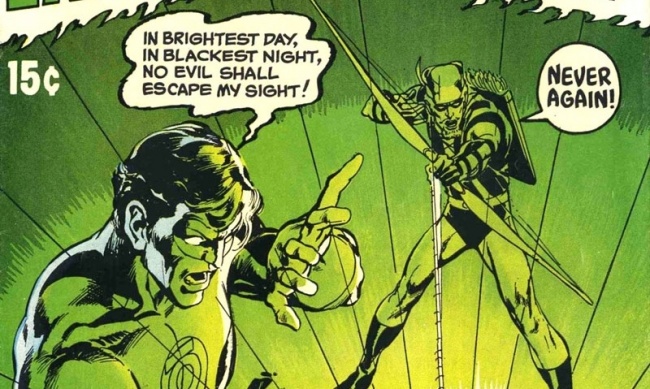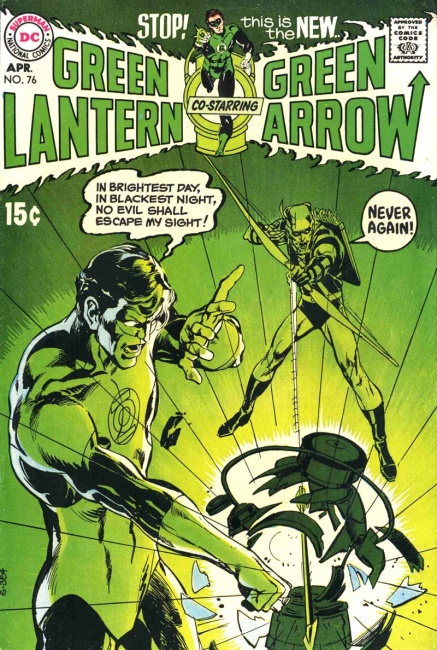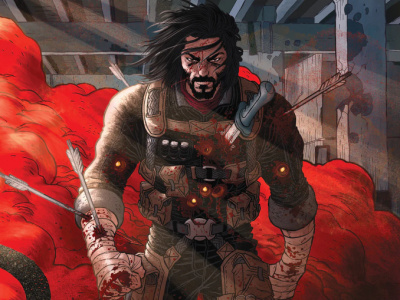It would be nice if news like this actually signaled something useful about the state of the comics art market, since original art is one of the few genuine, one-of-a-kind collectibles in a market largely devoted to the accumulation of mass-produced items. Unfortunately, most original art seems to circulate within a closed circle of dealers and collectors who benefit from the perception of nominal big-dollar sales, and who evaluate the art through the lens of fans rather than connoisseurs. That makes it hard to get a handle on exactly how popular original comics art is to the world as greater numbers of people become interested in both the subject matter and the aesthetics of the medium.
Why GL/GA #76 is relevant. As most comic fans know, GL/GA #76, cover-dated April, 1970, is not only the start of a classic run of issues by Adams, writer Denny O’Neil and inker Dick Giordano, but also one of several candidates for “first Bronze Age comic.” The scene of Green Arrow shooting the lantern out from under GL is one of the most iconic images in comics, and the story itself, featuring Green Lantern becoming aware of social issues and getting called out as a racist, may be the most frequently reprinted in the DC catalog.The equation here is pretty simple: historical significance plus aesthetic interest equals big bucks. To me, the only real surprise was the fact that it didn’t top records previously set by the last page of Incredible Hulk #180 (featuring the first published look at Wolverine) or the cover of Spider-Man #328, but who knows how people with that much money think about these things.
No evil escapes his sight. Another interesting thing about the sale of this piece was the inclusion of a note regarding the provenance of the piece. In 1970, most publishers didn’t return the original art to artists, and many pieces were either destroyed, given to fans by editors, or “vanished” from storerooms, probably into the hands of staffers. Few artists have been more critical of this practice than Adams, who for years refused to sign artwork that he judged as stolen, and reportedly threatened to initiate legal proceedings against collectors and dealers for trafficking in stolen property.
Heritage, doubtless mindful of this issue, included the following announcement prior to the auction from Adams himself:
…I would like to announce a New and Historical game-changer for collectors, historians and fans alike. Please let me be very clear. Whatever the origin and history of this cover has been since I first drew it, I'm here now announcing that, at the completion of this auction and during the auction I, Neal Adams, its creator and artist 100% approve of this auction, the sale and subsequent ownership of this cover.
That since the proprietor of the cover has agreed to equitably share the income of the auction with me and my family I hereby validate sale and ownership of this piece and I will, in fact, supply a Certificate of Authenticity to the highest bidder of the auction, and the ownership of this cover will never be questioned by me. This sharing of profit with the creator, of the sale of artwork produced back in those days when ownership has ever been in question, will in this case and may in all cases go far in bringing underground artwork into the light of a fair and open marketplace….
Earlier this year, I had occasion to talk to Adams informally at a convention about the issue of stolen art in general and his mood was very much “let bygones be bygones,” but it’s notable that Heritage and the “proprietor” (seller) of the cover made a specific accommodation to the creator. Considering how much Silver Age original artwork falls into this gray area, it would be very interesting if this arrangement set a precedent.
Meanwhile, in the real art market… While fan-favorite work from artists like Adams, Todd McFarlane and Gil Kane brings big bucks from mysterious bidders at auction, comic creators with more art world caché seem to be doing better in galleries. Earlier this month, Adam Baumgold Gallery, a fine arts dealer on E. 66th street in New York who specializes in upscale comics and graphic storytelling, opened an exhibit of works by Seth. This followed shows featuring Lynda Barry, Jules Feiffer, Charles Burns and others.
The same night, Scott Eder Gallery in Brooklyn was hosting the first-ever retrospective of works by underground cartoonist and publisher Denis Kitchen. Kitchen’s iconic “Giant Penis that Invaded New York” (cover of Bizarre Sex #1), was one of several pieces priced at $50,000 that sold almost instantly to private collectors.
In my hometown of Seattle, Fantagraphics’ book store and gallery hosts regular openings for independent cartoonists (up next: Mark Bodé), and art scene staple Roq La Rue mixes comics creators with an eclectic mix of pop art and contemporary pieces.
For arts’ sake. A broader awareness of the value of comics art as both fine art and a high-dollar collectible can only help independent artists seeking additional income. The recent Eventbrite survey showed art was the most popular convention purchase among all categories of fans, and a bunch of artists and studios seem to be doing a good business selling their work online on Etsy and DeviantArt.
Not every piece will set auction records, and not every sale will be as ethical as that of the GL/GA cover, but anything that contributes to the economic prospects of the creators, past and present, on whom the industry rests is a good thing.
--Rob Salkowitz (@robsalk) is the author of Comic-Con and the Business of Pop Culture.
The opinions expressed in this column are solely those of the writer, and do not necessarily reflect the views of the editorial staff of ICv2.com.










